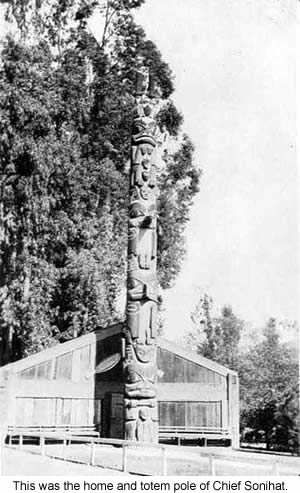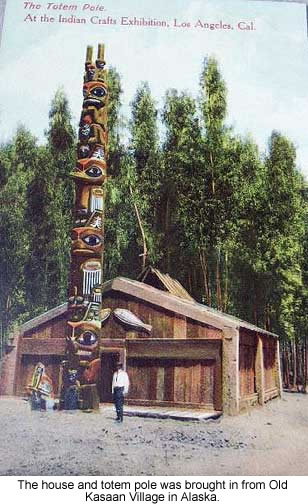 |
Canku Ota
|
 |
|
(Many Paths)
|
||
|
An Online Newsletter
Celebrating Native America
|
||
|
February 1, 2010 - Volume
8 Number 2
|
||
|
|
||
|
Totem Pole Going
Home
|
||
|
by Colorado Springs
Fine Arts Center press release
|
||
|
FAC
to return 51' foot tall pole to its original owners, a tribe in
Alaska COLORADO
SPRINGS (Jan. 15, 2010) – In 1951, the Colorado Springs Fine
Arts Center saved a totem pole from being turned into pulp at a
Los Angeles lumber yard.
When
the FAC underwent its renovation and expansion beginning in 2006,
during construction in the courtyard the pole was put into storage.
While in storage, FAC Curator Tariana Navas-Nieves had conversations
with representatives of the Haida peoples of Kasaan, Alaska, to
inquire about their wishes for the piece. The totem pole, named
for the tribe's Chief Son-i-Hat, originally stood in front of the
Chief's home at Old Kasaan. In
a significant stroke of good fortune, the tribe had recently begun
a fund-raising campaign to restore the Chief's home at Old Kasaan,
the only remaining traditional Haida longhouse in Alaska. That's
when the FAC offered to return the piece to the tribe. In a letter to the FAC, Richard Peterson, Village President, wrote, "The Organized Village of Kasaan, the federally recognized tribe for the indigenous Haida peoples of Kasaan, Alaska, extends a heart-felt "Haw'aa!" (HOW-uh, "Thank You!") to the Colorado Springs Fine Arts Center, the people of Colorado Springs, and all those involved with caring for the Chief Son-i-Hat totem pole." Native American tribes often struggle with art institutions to get their works back. "We commend and thank the Fine Arts Center for reaching out to us and actively seeking to return such an important piece of our culture and history," Peterson wrote. "As you may know, totem poles in the Haida Culture represent clans, serve as grave markers, and relate important events, etcetera. Bringing this important treasure home will serve to uplift our people and also serve as a testament of our historical presence." The Chief Son-I-Hat Whale House was listed in the National Register of Historic Places in 2002, and continues to offer a rich history that is important to Kasaan Haida people. Sharing information about the significance of Chief Son-I-Hat's house, and the need to restore it, is an essential part of Kasaan's efforts to document and preserve Kasaan Haida culture and history. The next step in the process is for the Haida tribe to formally petition for repatriation pursuant to the terms of the Native American Graves Protection and Repatriation Act (NAGPRA). "This is certainly one of my proudest achievements in my curatorial career," said Navas-Nieves. "We have made a significant connection with the Haida peoples of Kasaan, Alaska, and are honoring their history and heritage. I hope this inspires other institutions to respect the wishes of Native American tribes. The totem pole was enjoyed and loved by the Colorado Springs community for many years and now it is time for it to go back home. It is the right thing to do."
Public
Statement Regarding Chief Son-i-Hat Totem Pole: Hearing of the pole's existence surprised and excited our tribe. We were heartened to hear of the pole's being saved from a pulp mill at one point. We commend and thank the Fine Arts Center for reaching out to us and actively seeking to return such an important piece of our culture and history. As you may know, totem poles in the Haida Culture represent clans, serve as grave markers, relate important events, etcetera. Bringing this important treasure home will serve to uplift our people and also serve as a testament of our historical presence. We will formally petition for repatriation pursuant to the terms of the Native American Graves Protection and Repatriation Act (NAGPRA). Besides being one of the great chiefs of Old Kasaan, Son-i-Hat also had a home not far from present-day Kasaan. Earlier this year, along with the Kasaan Haida Heritage Foundation, we began fundraising efforts to restore this building, the only remaining traditional Haida longhouse in Alaska. We find the timing of your offer to return the Chief Son-i-Hat totem quite remarkable. Haw'aa!
Fine
Arts Center |
|
|
||
|
|
||
| Canku Ota is a free Newsletter celebrating Native America, its traditions and accomplishments . We do not provide subscriber or visitor names to anyone. Some articles presented in Canku Ota may contain copyright material. We have received appropriate permissions for republishing any articles. Material appearing here is distributed without profit or monetary gain to those who have expressed an interest. This is in accordance with Title 17 U.S.C. Section 107. | ||
|
Canku Ota is a copyright ©
2000, 2001, 2002, 2003, 2004, 2005, 2006, 2007, 2008, 2009, 2010
of Vicki Barry and Paul Barry.
|
||
 |
 |
|
|
The "Canku
Ota - A Newsletter Celebrating Native America" web site and
its design is the
|
||
|
Copyright ©
1999, 2000, 2001, 2002, 2003, 2004, 2005,
2006, 2007, 2008, 2009, 2010
of Paul C. Barry.
|
||
|
All Rights Reserved.
|
||
 The
FAC purchased the totem pole and for the next five decades, it was
displayed in the FAC Courtyard. The totem pole, made of yellow cedar,
was carved in ca. 1870 and stood 51-feet tall.
The
FAC purchased the totem pole and for the next five decades, it was
displayed in the FAC Courtyard. The totem pole, made of yellow cedar,
was carved in ca. 1870 and stood 51-feet tall. The
Organized Village of Kasaan, the federally recognized tribe for
the indigenous Haida peoples of Kasaan, Alaska, extends a heart-felt
"Haw'aa!" (HOW-uh, "Thank You!") to the Colorado Springs
Fine Arts Center, the people of Colorado Springs, and all those
involved with caring for the Chief Son-i-Hat totem pole. We are
honored to have the opportunity to bring home a totem which once
stood at Old Kasaan.
The
Organized Village of Kasaan, the federally recognized tribe for
the indigenous Haida peoples of Kasaan, Alaska, extends a heart-felt
"Haw'aa!" (HOW-uh, "Thank You!") to the Colorado Springs
Fine Arts Center, the people of Colorado Springs, and all those
involved with caring for the Chief Son-i-Hat totem pole. We are
honored to have the opportunity to bring home a totem which once
stood at Old Kasaan.